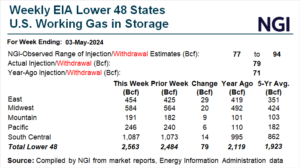Markets | Mexico | Natural Gas Prices | NGI All News Access | NGI The Weekly Gas Market Report
Natural Gas on Three-Week Bullish Run as U.S. Pipe Imports Stronger – Mexico Spotlight
© 2024 Natural Gas Intelligence. All rights reserved.
ISSN © 2577-9877 | ISSN © 2577-9966 | ISSN © 1532-1266 |


